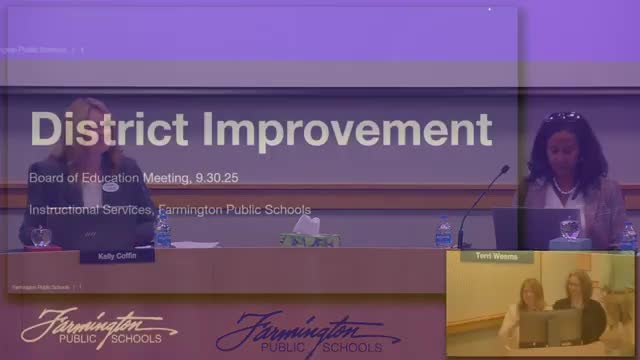Farmington board hears multi-year literacy and math progress, plans deeper implementation supports
October 01, 2025 | Farmington Public School District, School Boards, Michigan
This article was created by AI summarizing key points discussed. AI makes mistakes, so for full details and context, please refer to the video of the full meeting. Please report any errors so we can fix them. Report an error »

Assistant Superintendent Rhonda Henry and Director of Curriculum Margaret Hendrickson told the Farmington Public Schools Board of Education on Sept. 30 that district reading and math data show early multi‑year gains in some elementary cohorts but that districtwide performance remains mixed.
Henry and Hendrickson presented district and state assessment trends, early-impact highlights and a staged plan for K–12 literacy and mathematics. They said the district has rebuilt core literacy resources, expanded targeted intervention tools, and is increasing professional development and coaching to improve Tier 1 instruction and accelerate students who need additional support.
Hendrickson said the district is “not where we want to be” overall but that several elementary cohorts show steady growth. She highlighted a fifth‑grade cohort that rose from 47% to 54% proficiency in literacy over three years and cited double‑digit gains in some buildings with larger proportions of economically disadvantaged students. She said Farmington’s investments in EL Skills Block (foundational skills) and Wit & Wisdom (knowledge‑building curriculum) are entering their third and second years respectively and that targeted professional development on scaffolds and supports will be a priority this year.
On intervention strategies, Hendrickson described systemwide tiered supports: UFLI for foundational skill interventions, expanded use of small‑group instruction, and additional learning opportunities outside core instruction. For secondary literacy she highlighted Patterns of Power (language development) and efforts to contextualize texts to engage adolescent learners. For mathematics, the board heard that Farmington is rolling out Illustrative Mathematics districtwide at the secondary level and Magma Math (an AI‑supported tool) in core instruction; Delta Math will be used for interventions in grades 3–5.
Board members pressed for clearer dashboards and more accessible data. Trustee Heinrich asked for a regularly updated dashboard that ties specific interventions (for example, EL Skills Block, UFLI, Magma Math) to outcomes and shows classroom‑level and cohort progress. Several board members urged the district to keep “staying the course” and to continue professional development and coaching cycles so materials are used with fidelity.
Superintendent Dr. Coffin and Dr. Blau noted the work’s continuity: Coffin said staff are modeling multiple budget scenarios until the state budget is settled, while Blau added that district leaders have worked on literacy and math strategies for several years and have maintained continuity despite superintendent turnover at the district level. Board President Weems emphasized attendance as a priority, noting wide disparities in chronic absenteeism between economically disadvantaged students and peers.
The presentation included three-year trend graphics, examples of building-level gains (Wood Creek, Lanigan, Gill), and an outline of the district’s “blueprint” and its focus on tiered instruction, curriculum fidelity and professional development. Hendrickson said the district will continue to monitor the data cycle and report regular updates to the board.
Board members said they would return to the discussion in future meetings and consider dashboard design and board goals that reflect the data priorities presented.
Henry and Hendrickson presented district and state assessment trends, early-impact highlights and a staged plan for K–12 literacy and mathematics. They said the district has rebuilt core literacy resources, expanded targeted intervention tools, and is increasing professional development and coaching to improve Tier 1 instruction and accelerate students who need additional support.
Hendrickson said the district is “not where we want to be” overall but that several elementary cohorts show steady growth. She highlighted a fifth‑grade cohort that rose from 47% to 54% proficiency in literacy over three years and cited double‑digit gains in some buildings with larger proportions of economically disadvantaged students. She said Farmington’s investments in EL Skills Block (foundational skills) and Wit & Wisdom (knowledge‑building curriculum) are entering their third and second years respectively and that targeted professional development on scaffolds and supports will be a priority this year.
On intervention strategies, Hendrickson described systemwide tiered supports: UFLI for foundational skill interventions, expanded use of small‑group instruction, and additional learning opportunities outside core instruction. For secondary literacy she highlighted Patterns of Power (language development) and efforts to contextualize texts to engage adolescent learners. For mathematics, the board heard that Farmington is rolling out Illustrative Mathematics districtwide at the secondary level and Magma Math (an AI‑supported tool) in core instruction; Delta Math will be used for interventions in grades 3–5.
Board members pressed for clearer dashboards and more accessible data. Trustee Heinrich asked for a regularly updated dashboard that ties specific interventions (for example, EL Skills Block, UFLI, Magma Math) to outcomes and shows classroom‑level and cohort progress. Several board members urged the district to keep “staying the course” and to continue professional development and coaching cycles so materials are used with fidelity.
Superintendent Dr. Coffin and Dr. Blau noted the work’s continuity: Coffin said staff are modeling multiple budget scenarios until the state budget is settled, while Blau added that district leaders have worked on literacy and math strategies for several years and have maintained continuity despite superintendent turnover at the district level. Board President Weems emphasized attendance as a priority, noting wide disparities in chronic absenteeism between economically disadvantaged students and peers.
The presentation included three-year trend graphics, examples of building-level gains (Wood Creek, Lanigan, Gill), and an outline of the district’s “blueprint” and its focus on tiered instruction, curriculum fidelity and professional development. Hendrickson said the district will continue to monitor the data cycle and report regular updates to the board.
Board members said they would return to the discussion in future meetings and consider dashboard design and board goals that reflect the data priorities presented.
View full meeting
This article is based on a recent meeting—watch the full video and explore the complete transcript for deeper insights into the discussion.
View full meeting
